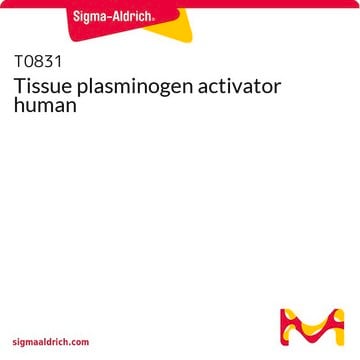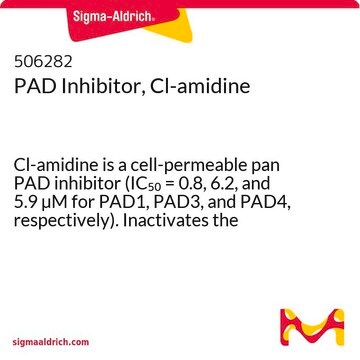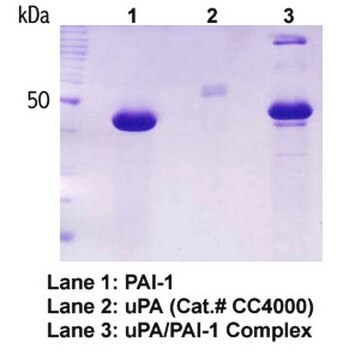528205
Plasminogen Activator Inhibitor-1, Human, Recombinant
The Plasminogen Activator Inhibitor-1, Human, Recombinant controls the biological activity of Plasminogen Activator. This small molecule/inhibitor is primarily used for Protease Inhibitors applications.
Synonym(s):
PAI-1
Sign Into View Organizational & Contract Pricing
All Photos(1)
About This Item
UNSPSC Code:
12352200
NACRES:
NA.77
Recommended Products
Quality Level
Assay
≥98% (SDS-PAGE)
form
liquid
manufacturer/tradename
Calbiochem®
storage condition
OK to freeze
avoid repeated freeze/thaw cycles
shipped in
wet ice
storage temp.
−70°C
General description
PAI-1 is the primary inhibitor of both tissue plasminogen activator (tPA) and urokinase (uPA). PAI-1 can exist either in an active inhibitory conformation or in an inactive or latent conformation. This highly purified preparation has not been exposed to denaturing conditions and has been chromatographically purified of latent material. PAI-1 is a marker for acute myocardial infarction and several thrombolytic disorders. Protects platelets against the inhibitory effects of plasma. Reported to be an important prognostic factor in breast cancer patients. PAI-1 is highly stable when stored at or below pH 6.6.
Primary inhibitor of both tissue plasminogen activator (tPA) and urokinase (uPA). PAI-1 is synthesized by vascular epithelium and hepatocytes. Used as a marker for acute myocardial infarction and in the diagnosis of several thrombolytic disorders. Protects platelets against the inhibitory effects of plasma. Shown to have a role complimentary to that of α2-anti-plasmin. Elevated levels are found in subjects with accelerated coronary artery disease. PP1 activity may limit the extent of metastasis, since uPA activity is a major contributory factor promoting dissolution of tumor matrix and basement membrane. May serve as an independent and strong prognosticator in breast cancer patients. Patients having elevated levels of PAI-1 in their primary tumors are more prone to relapse. Can exist either in an active inhibitory conformation or in an inactive or latent conformation. This highly purified preparation has not been exposed to denaturing conditions and has been chromatographically purified free of the inactive material.
Biochem/physiol Actions
Cell permeable: no
Primary Target
Tissue plasminogen activator (tPA) and urokinase (uPA)
Tissue plasminogen activator (tPA) and urokinase (uPA)
Product does not compete with ATP.
Reversible: no
Warning
Toxicity: Standard Handling (A)
Physical form
In 150 mM NaCl, 50 mM sodium phosphate buffer, 1 mM EDTA, pH 6.6.
Reconstitution
Following initial thaw, aliquot and freeze (-70°C).
Other Notes
Vaughan, D.E., et al. 1995. J. Clin. Invest. 95, 995.
Dimitri, G., et al. 1993. Boll. Chim. Farmaceutico 132, 272.
Janicke, F., et al. 1993. Breast Cancer Res. Treatment 24, 195.
Klasser, K.J., et al. 1993. Coron. Artery Dis. 4, 713.
Robbie, L.A., et al. 1993. Thromb. Hemost.70, 307.
Lawrence, D., et al. 1989. Eur. J. Biochem.186, 523.
Collen, D. and Lijnen, H.R. 1987. In The Molecular Basis of Blood Diseases (Stamatoyannopoulus, G., et al. Eds.) W.B. Saunders
Ginsberg, D., et al. 1986. J. Clin. Invest.78, 1673.
Vassalli, J.D., et al. 1985. J. Cell Biol.100, 86.
Dimitri, G., et al. 1993. Boll. Chim. Farmaceutico 132, 272.
Janicke, F., et al. 1993. Breast Cancer Res. Treatment 24, 195.
Klasser, K.J., et al. 1993. Coron. Artery Dis. 4, 713.
Robbie, L.A., et al. 1993. Thromb. Hemost.70, 307.
Lawrence, D., et al. 1989. Eur. J. Biochem.186, 523.
Collen, D. and Lijnen, H.R. 1987. In The Molecular Basis of Blood Diseases (Stamatoyannopoulus, G., et al. Eds.) W.B. Saunders
Ginsberg, D., et al. 1986. J. Clin. Invest.78, 1673.
Vassalli, J.D., et al. 1985. J. Cell Biol.100, 86.
Legal Information
CALBIOCHEM is a registered trademark of Merck KGaA, Darmstadt, Germany
Storage Class Code
10 - Combustible liquids
WGK
WGK 1
Flash Point(F)
Not applicable
Flash Point(C)
Not applicable
Certificates of Analysis (COA)
Search for Certificates of Analysis (COA) by entering the products Lot/Batch Number. Lot and Batch Numbers can be found on a product’s label following the words ‘Lot’ or ‘Batch’.
Already Own This Product?
Find documentation for the products that you have recently purchased in the Document Library.
Our team of scientists has experience in all areas of research including Life Science, Material Science, Chemical Synthesis, Chromatography, Analytical and many others.
Contact Technical Service








